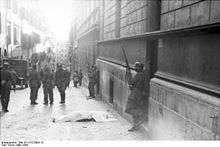Massacre in Rome
Massacre in Rome (Italian: Rappresaglia) is a 1973 Italian war drama film directed by George Pan Cosmatos[1] about the Ardeatine massacre which occurred at the Ardeatine caves in Rome, 24 March 1944, committed by the Germans as a reprisal for a partisan attack against the SS Police Regiment Bozen.
| Massacre in Rome | |
|---|---|
 UK DVD Cover | |
| Directed by | George P. Cosmatos |
| Produced by | Carlo Ponti |
| Written by | Robert Katz (book) George P. Cosmatos |
| Starring | Richard Burton Marcello Mastroianni |
| Music by | Ennio Morricone |
| Cinematography | Marcello Gatti |
| Edited by | Françoise Bonnot |
Release date | 4 October 1973 |
Running time | 110 minutes |
| Country | Italy |
| Language | English |
Plot
The film stars Richard Burton as the Rome Gestapo chief Herbert Kappler, who carries out the killings of 335 mostly randomly and hurriedly selected victims in revenge for partisans killing 33 Germans: using a ratio of ten Italian victims for every German. However, they had rounded up five more than expected but continued on with their plan. Meanwhile, the Vatican stands by and issues no condemnation.
Cast
SS personnel
- Richard Burton as SS-Obersturmbannführer Herbert Kappler
- John Steiner as SS-Standartenführer Eugen Dollmann
- Anthony Steel as SS-Sturmbannführer Domizlaf
- Brook Williams as SS-Hauptsturmführer Erich Priebke
- Dennis Burgess as SS-Sturmbannführer Hellmuth Dobbrick
- Anthony Dawson as SS-Brigadeführer Wilhelm Harster
Luftwaffe officers
- Peter Vaughan as Field Marshal Albert Kesselring
- Leo McKern as Luftwaffe General Kurt Mälzer
Italian fascists
- Guidarino Guidi as Interior Minister Guido Buffarini Guidi
- Renzo Montagnani as Police Chief "Questore" Pietro Caruso
Vatican officials
- Marcello Mastroianni as Father Pietro Antonelli
- Robert Harris as Father Pancrazio
Other characters
- Giancarlo Prete as Paolo
- Delia Boccardo as Elena
- Renzo Palmer as Giorgio
- Duilio Del Prete as Partisan
Production
The film is based on the book Death in Rome by Robert Katz, who did the screenplay with Cosmatos.
The names of the victims are shown in the closing credits, as opposed to the cast credits and crew members.
Historical accuracy
Herbert Kappler is depicted in the film as being a tired worn out man, who is disillusioned with the Nazi cause and believes that the fall of Nazi Germany is imminent. In reality, Kappler was a zealous Nazi and was sent to Rome for exactly this reason. During his time as head of the Sicherheitspolizei (Security Police) in Rome, Kappler organized the round-ups of thousands of innocent victims, oversaw raids on Jewish homes for looted valuables, and was a key figure in transporting Italian Jews to Nazi death camps.
Father Pietro Antonelli is a combination of several different Vatican officials who personally knew Kappler, the most significant of whom was Monsignor Hugh O'Flaherty (who appears in the television film The Scarlet and the Black). One prisoner, a deserter from the Austrian army who had pretended to be an Italian, was allowed to live, as a citizen of the Reich; and he was the only witness to tell the tale of the courageous behaviour of the Resistance priest, Don Pietro Pappagallo, who blessed those about to be killed, before he himself met his fate.

The SS victims of the partisan attack are referred to throughout the film as "German soldiers", when in fact the company which was attacked was part of the "Battalion Bozen", which was composed of ethnic Austrians from German-speaking South Tyrol annexed by Italy after the First World War. Historically, the unit also did not wear SS uniforms, but rather regular German police uniforms of the Ordnungspolizei.
Kurt Mälzer is shown throughout the film giving direct orders to SS units and personally supervising the buildup to the massacre organized by Kappler. In reality, while several regular Wehrmacht officers did issue orders to the SS during this period, as well as Kappler and Mälzer personally discussing the operation, Kappler and his men were under the SS and Police Leader chain of command, and it was through these channels that most of the official orders concerning the massacre were issued. Another man working with the SS was Capt. Erich Priebke, who is mentioned in the film. He had full knowledge of the massacre, but would hide for many years evading justice. Then, on Nationwide TV in the 1990s, ABC News reporter Sam Donaldson found and confronted him about the massacre, leading him to say he "followed orders". Argentinian authorities quickly arrested and extradited him to Italy; he was tried and convicted of mass murder.
Colonel Dollmann was never Kappler's direct superior, as is implied several times in the film. In reality, Kappler answered to the office of SS-Obergruppenführer Karl Wolff, who also maintained his headquarters in Rome. Wolff is never seen or mentioned in the film. In reality, he stood trial and was found guilty of killing Italian Jews as part of the operations in Italy: when he became sick, his sentence was reduced and he was released in 1971.
At the time of the massacre, Herbert Kappler was 37 years old. Actor Richard Burton was just short of his 48th birthday when the film was produced, eleven years older than Kappler would have been at the time.
References
- "NY Times: Massacre in Rome". NY Times.com. Retrieved 28 March 2009.